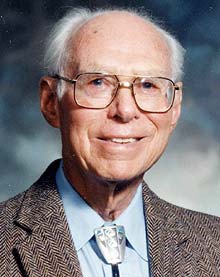| John
Pierce
Apr 11th 2002
From The Economist print edition John Robinson Pierce, satellite communications pioneer, died on April 2nd, aged 92
ONLY the technically minded are likely to have read John Pierce's “Theory and Design of Electron Beams”, but many thousands, perhaps millions, will have devoured his stories in magazines such as Astounding Science Fiction, written under the pseudonym J.J. Coupling. Mr Pierce did not try to keep his fiction writing a secret, but nor did he publicise it. In reference books he lists his leisure interests as “writing, science fiction”, with the comma separating the two pursuits. Scientists have enough trouble getting backing for their projects without giving ammunition to their opponents. “Another fantasy idea of yours, eh Mr Pierce?” He could do without that. John Pierce appreciated that most of the great leaps forward in technology were anticipated by writers and others before the means became available to turn them into reality. Leonardo designed a flying machine; Hero of Alexandria, a Greek, experimented with steam power 2,000 years ago. In 1962 Mr Pierce designed and launched Telstar 1, the first communications satellite to be used commercially. But years earlier Arthur C. Clarke, a British science-fiction writer who had trained as an engineer, had proposed such a system of communications. Mr Pierce, he said, had made real what “I and others thought only to write and dream about.” Towards the end of his long life, Mr Pierce noted that science fiction was at last being taken seriously by those who saw it as an aid to making a calculated guess about the problems of the future. An American academic writing on the Internet says that he uses “hard science fiction” to acquaint his students with, for example, what it will be like for humans to make their first expedition to Mars. Fiction could show the creative thought that leads to a solution. Good writers, he says, try not to break scientific laws. What about space epics in movies and television? Steady there. This is academe. John Pierce published his first fiction in 1930 in Science Wonder Stories. It helped to pay his expenses while studying at the California Institute of Technology. In the mid-1930s, when he left the institute with a doctorate in electronics, he was taken on by Bell Telephone Laboratories, founded by the inventor of the telephone and in its day the most famous scientific research and development organisation in the world. He was to stay there for 35 years. When Bell workers invented a small electronic switch they were wondering what to call it. Mr Pierce the wordsmith suggested “transistor”, and that stuck, to be applied to many now indispensable things from radios to computers. He would often have to explain that he did not invent the transistor; but he did give it its name. In the second world war Mr Pierce worked on radar, in which signals directed at an object are bounced back to the transmitter. In the 1950s, when the first artificial satellites were being launched, first by the Russians then by the United States, Mr Pierce calculated that 25 of them, suitably placed, could provide almost continuous communication around the world by bouncing signals from continent to continent. In 1960 a metal-coated plastic balloon 100ft across sent up by America's space agency was used by Bell to bounce telephone calls to distant destinations in the United States. Mr Pierce's Telstar, launched two years later, carried television pictures between America and Europe as well as phone calls. Meanwhile, the reputation of J.J. Coup-ling was growing apace. His editors asked what the initials stood for. In physics, the author explained, J.J. Coupling is a process for determining the wave function of an atom that has a large number of electrons. Well, of course. Now, J.J., what are you up to at the moment? Mr Pierce was up to many things. His technical writing took up a lot of his time. In the course of his career he wrote or contributed to 20 books, and more than 300 papers. He liked to invent things and was granted some 90 patents. He was fond of gliding and of music composed by computer; at Stanford University he was for 12 years a professor of music and never asked for a salary. He won many prizes and received dozens of honorary degrees. Science fiction? Yes, it remained an interest. But one problem for writers, Mr Pierce found, was the timing of the future. In “2001: A Space Odyssey”, a film made in 1968, his friend Arthur Clarke had assumed that space travel would soon become commonplace. In 2002 that prospect still remains a distant improbability. Mr Pierce may have better luck with his stories about cyborgs, mechanical people, an idea that has intrigued inventors since Carlo Collodi wrote “Pinocchio” in 1881. Mr Pierce's story “Period Piece” was written in 1948 but wisely set well ahead sometime in the 21st century. It concerns a cyborg called Smith who in most respects looks human. But he begins to suspect that he is only “a charming mechanical toy”. Smith discovers he has not been provided with sexual feelings like a real human, and understandably feels rebellious. J.J. Coupling/John Pierce may have done science yet another service by identifying a tricky future problem here. Should cyborgs have sex? It would surely be an almost-human right.
|
||||

